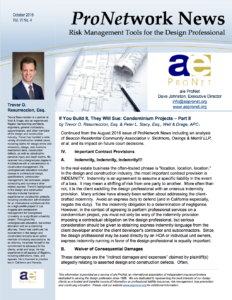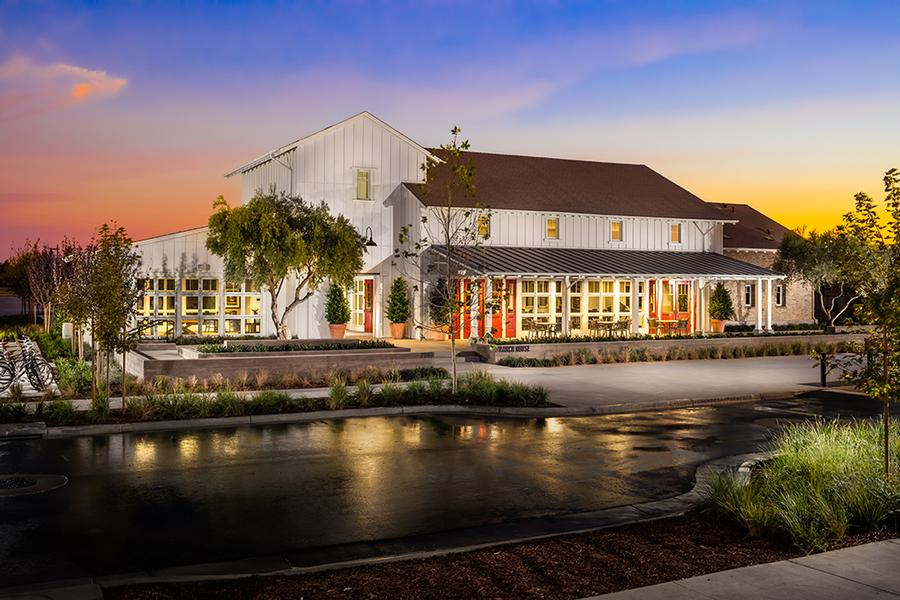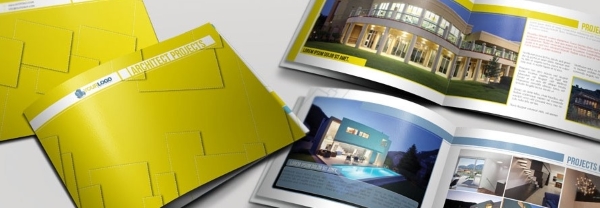 Continued from the August 2016 issue of ProNetwork News including an analysis of Beacon Residential Community Association v. Skidmore, Owings & Merrill LLP, et al. and its impact on future court decisions.
Continued from the August 2016 issue of ProNetwork News including an analysis of Beacon Residential Community Association v. Skidmore, Owings & Merrill LLP, et al. and its impact on future court decisions.
IV. Important Contract Provisions
A. Indemnity, Indemnity, Indemnity!!!
In the real estate business the often-touted phrase is “location, location, location.” In the design and construction industry, the most important contract provision is INDEMNITY. Indemnity is an agreement to assume a specific liability in the event of a loss. It may mean a shifting of risk from one party to another. More often than not, it is the client saddling the design professional with an onerous indemnity provision. Many articles have already been written about addressing the client-drafted indemnity. Avoid an express duty to defend (and in California especially, negate this duty). Tie the indemnity obligation to a determination of negligence. However, in the context of agreeing to perform professional services on a condominium project, you must not only be wary of the indemnity provision imposing a contractual obligation on the design professional, but serious consideration should be given to obtaining express indemnity language from the client developer and/or the client developer’s contractor and subcontractors. Since the design professional may be sued directly by an HOA or individual unit owners, express indemnity running in favor of the design professional is equally important.
B. Waiver of Consequential Damages
These damages are the “indirect damages and expenses” claimed by plaintiff(s) allegedly relating to asserted design and construction defects. Often, consequential damages include damages relating to delays, loss of use, lost profits, etc. It is a balancing provision in that it should recognize, much like a limitation of liability (discussed further below), that there are relative risks and rewards for each party’s participation on the project. As was commonplace during the recent recession, some client developers pursued claims against design professionals and contractors for missed market opportunities to sell their individual units before the housing bubble burst. The design professional has no control over such market factors. A properly-worded, mutual waiver of consequential damages is an appropriate way to address this.
C. Limitation of Liability
Given the increased risk of being sued on a condominium project, a limitation of liability (overall cap) of the design professional from the client developer is essential. A limitation of liability provision can be tied to the amount of available insurance, the architect’s total fee, or some other amount as negotiated between the parties to the contract. The limitation of liability provision should be negotiated at arm’s length such that both parties have the opportunity to accept, reject or modify the provision.
This is an excerpt of the October 2016 issue of ProNetwork News. Download the full PDF of If You Build It, They Will Sue: Condominium Projects – Part II to continue reading. Along with further explanation of the relevance of The Beacon Case, the second in this two-part series provides an overview of several more important contract provisions, including: No Third-Party Beneficiaries, The Certification of Merit, and Provisions Requiring the Developer and Subsequent Owners to Include Maintenance Requirements and Manuals in CC&Rs and Purchase Agreements. As always, these newsletters are available to a/e ProNet clients the month they are published. If you’d like to take advantage of this value-added service, get in touch with your local a/e ProNet broker today.
About the Author
Trevor Resurreccion is a partner at Weil & Drage, and an experienced litigator representing architects, engineers, general contractors, subcontractors, and other members of the design and construction industry. Trevor has handled a wide variety of construction related cases, including claims for design errors and omissions, delays, cost overruns, mechanic’s liens, construction defects, as well as catastrophic personal injury and death claims. He received his undergraduate degree in Architecture with a concentration in construction management. Trevor’s background in the design and construction industry includes hands-on experience on construction projects, including construction administration for an international architectural firm on a high-profile project in Los Angeles and construction management for Georgetown University on a significant university project. As an attorney, he prides himself in his commitment to advocacy for his clients, small and large. He has experience in all aspects of litigation, including arbitrations, trials, and appeals. He is licensed to practice law in California and Nevada.




 Do architects owe a “duty of care” to the homeowners of a condominium project with whom the architects have no contractual privity? According to the California Supreme Court, they do. What does this mean in practical terms? The answer is that architects are now more than ever exposed to potential future claims and lawsuits brought by homeowners and the homeowners’ associations years after the project has been completed even where the architect’s design decisions are trumped by those of the project developer, and the architect’s role in the construction phase of the project is limited.
Do architects owe a “duty of care” to the homeowners of a condominium project with whom the architects have no contractual privity? According to the California Supreme Court, they do. What does this mean in practical terms? The answer is that architects are now more than ever exposed to potential future claims and lawsuits brought by homeowners and the homeowners’ associations years after the project has been completed even where the architect’s design decisions are trumped by those of the project developer, and the architect’s role in the construction phase of the project is limited.




